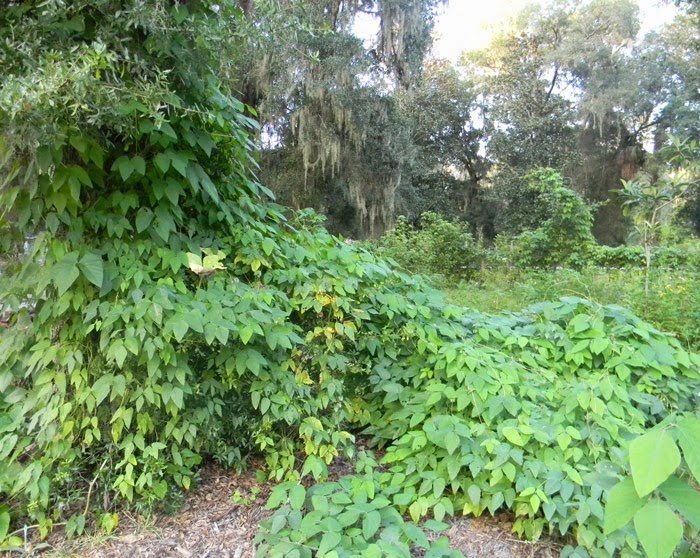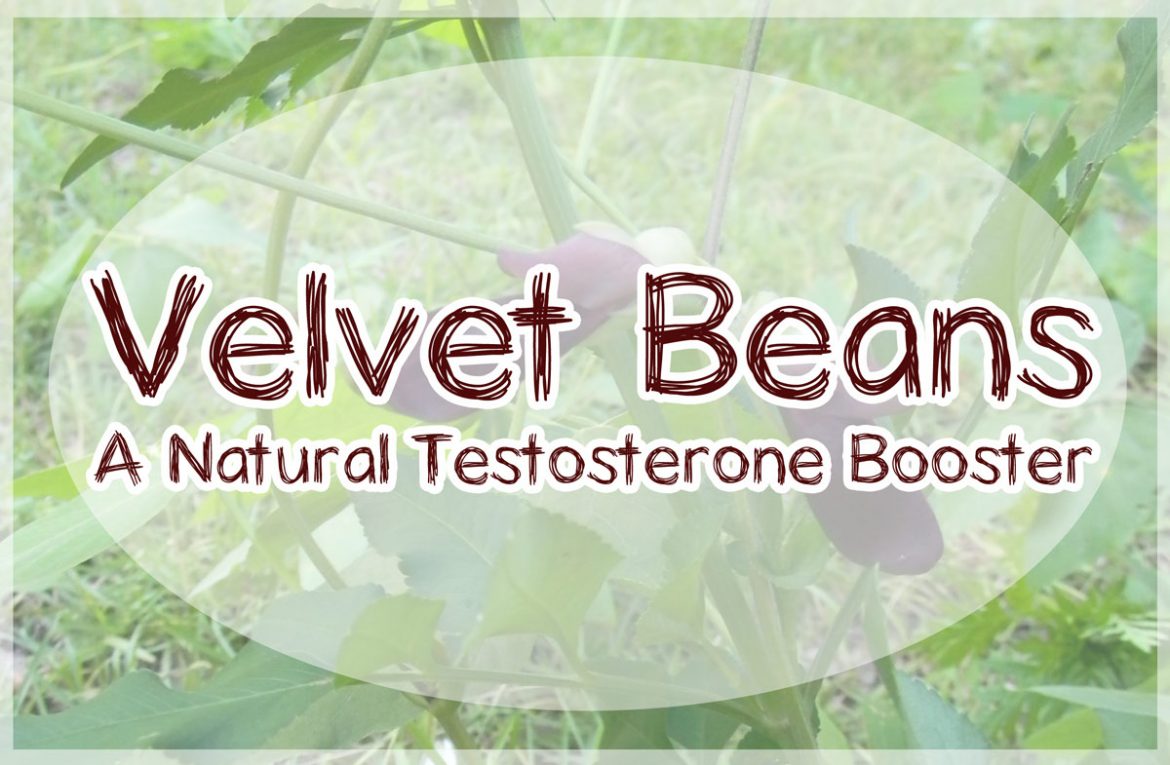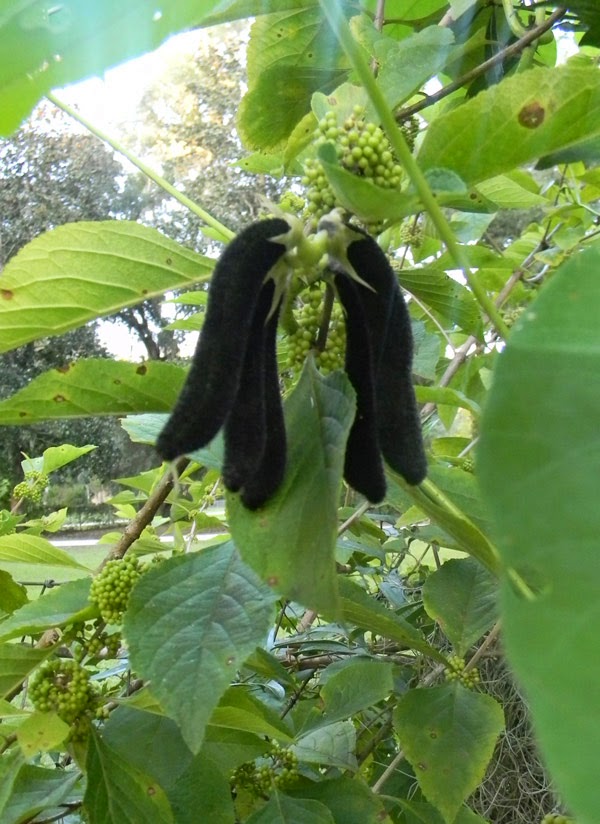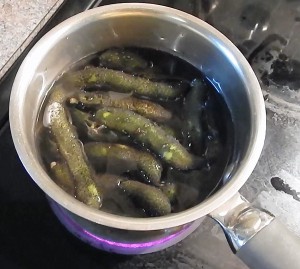If you’re looking for a natural testosterone booster that will raise your sense of well-being and give you extra energy… velvet beans are the answer.
Why Velvet Beans?
Velvet beans not only boost testosterone, however; they also raise dopamine levels and make you feel better about life in general.
Velvet beans (known in Latin as Mucuna pruriens) are becoming a hot commodity. The seeds are rather expensive now that they’re becoming better known as a health supplement. For a crazy amount of information on the health benefits of velvet beans, check out this article. They’re well-known as a natural aphrodisiac among other pleasant benefits.
Fortunately, once you have seeds you can grow lots and lots of them provided you have a long enough season. Here in North Florida velvet beans grow like weeds. Here they are eating one of my oak trees:

You wouldn’t guess a crazy vigorous plant like this would be a natural testosterone booster, would you? Naw.
Growing Velvet Beans
Growing velvet beans is easier than easy.
Plant velvet beans in spring after all danger of frost and give them something they can climb – just be aware that they will completely cover small trees and shrubs. Even moderately large trees can get overwhelmed with their strong, twisting vines.
In other words, don’t plant velvet beans next to your award-winning camellias.
They can tolerate some shade but do best in full sun. Poor soil isn’t a big deal – they can handle it, thanks to their nitrogen-fixing ability.
Give them hot weather and lots of rainfall and they grow wonderfully. If it’s not rainy, irrigation will get them growing faster; however, I plant mine in half-wild parts of the yard and never water… and I still get plenty of beans.
I’ve even guerrilla planted them in empty lots around my neighborhood and had them grow pretty well. If the soil were good enough, I think they’d naturalize (they’ve almost done so in my food forest – I always have a few plants every year even without planting new ones).
NOTE: There are wilder forms of velvet beans that are covered with stinging hairs, giving them the name “madness bean.” The ones I grow have mostly had that trait bred out of them, though handling the fuzzy velvet pods can make you a little bit itchy, particularly if you have sensitive skin.
Harvesting Velvet Beans
Velvet bean pods are ready for the table when the beans inside have filled out nicely but the pods haven’t dried out. If you want velvet bean seeds you need to let them dry on the vine until the pods are nice and hard. The seeds can be roasted and used as a coffee substitute, though they unfortunately lack caffeine. The dry beans are also used as a health supplement, though I have stuck to the tasty green beans instead.
Preparing and Cooking Velvet Beans
Velvet beans are powerful medicine and contain a wide range of bioactive compounds. A friend of mine ate quite a few of them on a daily basis and ended up with migraines. A few is good enough – though they taste so good cooked that you’ll want to eat lots and lots.
Restrain yourself!
You don’t want to end up dealing with both a sexual harassment lawsuit AND a migraine, do you? I didn’t think so.
I pick the beans when they’re filled out and green, put them in a pot, cover with water, add lots of sea salt, then boil until they soften and start to split open revealing the tasty beans inside.
The pods themselves are tough and inedible, but the seeds inside taste like really good boiled green peanuts.
Once I’ve cooked my green velvet beans, I shell them, dry the green beans off and then freeze them so I can ration out beans through the year. The pods are only produced in the late summer and fall so you need to plan ahead.
I eat five velvet beans a day for a few weeks, then quit for a week, then do it again. John Starnes’ video on velvet beans introduced me to the on-and-off approach and it’s supposed to help keep your body from getting too used to the dopamine and testosterone effects. Seems to work well!
So – there you have it – a natural testosterone booster you can grow in your garden.
To see what they look like growing on the vine and how I cook them, check out my new video on velvet beans:
Start growing velvet beans next spring and have fun. If you work out or need more pep (or a natural aphrodisiac) velvet beans are for you.




27 comments
Hey David, great post! Can you recommend a view options for purchasing seeds?
Also, unrelated: since you live in Florida and I see in several of your pictures that you, like me, have an abundance of Spanish moss growing in your treas. I just moved to my property in central Florida about three months ago. I want to tear a lot of the Spanish moss down but want to use it in my garden bed establishment. I have read that it makes great ground cover but also gets infested with chigger (red bugs). Have you used it in compost, compost tea, or just tilled it into the soil? If so, what kind of results did you see from it?
Appreciate your answer!
I’ve never gotten chiggers from Spanish moss and I’ve handled it quite a bit. That doesn’t mean the tales are untrue, but I do think they’re greatly exaggerated. I’ve composted it and used it as mulch. It takes a while to rot down but does work well. Tilling under would probably be touch since it would wrap all around a tiller. I wouldn’t be afraid of it at all.
On velvet bean seeds, they’re tough to find. I don’t have any trusted sources other than other gardeners here and there.
Thanks for the answer!
Hello,
My name is Chidozie Anikpe ,
I am a Nigerian and live in the nations capital Abuja. you can reach me on mydozie@yahoo.co.uk for possible supply of the bean/seed.
Regards,
Chidozie
http://petcherseeds.com/velvet-beans/ source for seed as well as other info
Thanks, Byron!
I have about 2 acres of them growing now (covering land exposed after an earthworks project early in the Spring). They look very happy – the whole thing is a mess 3′ high that you can’t walk through and even the most aggressive species that normally would be a big problem in this situation are barely surviving somewhere under the beans. No pods though – I think they need support to actually produce pods. Or may be it’s too early.
P.S. Haven’t had a chance to comment for a while but I do my best to read! Keep up the good work :)
Hey! Welcome back!
They do cover the ground like mad. I’ve even had them kill out weeds in the shade.
Some of mine are just starting to bloom. They might be day-length sensitive. You’ll probably get some seed.
Looks like we both were right – many pods now but only on plants that climbed on something, like a tree or taller plant (it doesn’t work that good for the plants they climb on). Many of the ones that didn’t have support are half dead now – all the leaves are gone, etc. I can’t prove it but somehow I’m pretty sure that has something to do with a lot of rain we had in Sep (almost 10″ as of now it’s actually raining again).
Hi , please get in touch with me at your convenience , I’m interested in purchasing some beans . I’m a farmer in homestead Florida
BTW, the whole 2 acres were planted with less than a pound of beans.
That’s amazing.
Hi,
I wonder if you can help / advise me. I live in Thailand and have a (very) large farm which l intend to grow the Mucuna / velvet bean.
I am a little confused about the cooking / eating of these beans – without the cooking process destroying all the beneficial qualities.
Do l boil the old seeds or the whole young seed pod? If l roast them and grind them for “coffee” – will l still get the natural health benefits? I would hate to cook them and reduce or remove the beneficial / medicinal qualities.
I am also wondering about possible export. Do you think there is still a market for fresh beans?
Thank you in anticipation.
Tim
Hi Tim,
I cook the entire pod when the seeds have swollen inside but the pod hasn’t begun to dry out. Eating more than a few beans at a time is not recommended, however. They’re supposed to be more toxic raw. Dry seeds have the highest toxicity. A friend experienced headaches after eating more than a handful of cooked green beans. The young pods are probably too leathery to eat. The best use for them, other than as a testosterone/mood enhancer, I believe, is as a “green manure.” They fix a lot of nitrogen.
Good luck – wish I had more information for you.
Hi ?. I become a bit sad to read that mucuna beans are not edible as usual beans. One of my friend sent me a kilo of mucuna seeds which i had a plan to plant in my small farm.I was told my fried that MUCUNA works better in improving soil fertility. After googling , i found the grain is so reach in various benefits yet is said to be toxic to human consumptions as normal beans !.I ‘m very interested to grow in a large scale ,since it seems simple to grow it !.Apart from improving my land, i wanted it to make it as source of income .
Now from you , i wanted to know the following :
1. Where to get the market if i produce a large quantity .
2. How to process the grain in family scale to maximize the crop utility ?.
Hi!
I just got “traditional sri Lankan seeds ” and they are called velvet bean as well. So I suppose the growing conditions for Sri Lanka will be similar to yours ?
If it’s the same species (Mucuna pruriens), yes – should be the same growing methods.
[…] If you’re a man and want to consume a bean that does the opposite of soy, grow these. […]
Son of a gun, my internet went out right as I tried to submit. So I apologize if this message comes through twice!
Hi David, this is CJ in Mims. What do you think of the idea of simply cooking a small amount of the dry beans in a pot of regular cooking beans? Like black beans, cowpeas, purple hulls, Black Eyed Peas, etc. Maybe a doz dried velvet beans per serving. I usually cook a pot of beans every week or two anyway, with smoked pork or pickle meat, lots of garlic and onion, hot peppers, yum! it shouldn’t take many plants to yield a Jar full of dry beans to keep on the kitchen counter to last through the year. I’ve got a big dead orange tree out back that would make the perfect trellis! I wonder if cooking affects the l-dopa? – CJ
BTW, I’m happy to see posting on YT again!
I’d do it – I would boil mine until soft, then eat them. It would be awesome.
Can you please tell me where I can buy mucuna velvet bean’s fresh so I can boil them thank you
Am a resident of western Kenya in east Africa, how can I get the velvet beans seeds?
To plant velvet bea
Nice post.
We have mainly the wild ones, with stinging pods, greatly feared, growing in eastern Nigeria.
Those who can harvest the pods, use it as weapon, to make their enemies scratch like crazy.
I never new that it’s seeds can be eaten.
Thanks.
The wild ones are brutal!
Hey David, Greetings from India! Very nice article. I’ve watched quite a few of your videos, somehow missed your website
BTW, velvet beans have been used in ayurveda as a cure for Alzheimer’s. They’re also extremely effective as preventive medicine against snakebites, usually the cobra and Krait. These benefits aren’t old wives tales, there are published articles on various scientific research platforms which can corroborate the benefits.
I live in Bangalore City, where snakes are quite common, along with mongooses and the ocassional leopard . Reputed local snake rescuers swallow a couple of whole mucuna seeds every day to immunize themselves against snakebites.
Oh, and it’s the black variety which seems to have the maximum benefits. The white bean tastes better, but maybe half as effective as the black variety.
Hi David, I ate five beans well rinsed and roasted velvet beans four times and two of the times I got retinol migraine without the headache. Scared me to death. I didn’t know what a retinol migraine was and thought I was having a stroke but called my uncle who is an optomologist and he told me that’s what it was. I experienced very vivid mosaic pattern in one eye and then blind spots. Wondering if you know anything more about the migraine effect as this is the only place I’ve seen any anecdotal info about it causing migraines for anyone else?
Comments are closed.